traction control TOYOTA TACOMA 2011 Owners Manual (in English)
[x] Cancel search | Manufacturer: TOYOTA, Model Year: 2011, Model line: TACOMA, Model: TOYOTA TACOMA 2011Pages: 548, PDF Size: 9.86 MB
Page 3 of 548

1
2
3
4
5
6
7
3
2-4. Using other driving systemsCruise control ...................... 171
Rear view monitor system (vehicles with auto
anti-glare inside rear view
mirror) ............................... 174
Four-wheel drive system ..... 178
Active traction control system .............................. 182
AUTO LSD system.............. 184
Rear differential lock system .............................. 186
Downhill Assist Control system .............................. 189
Clutch start cancel switch ... 191
Driving assist systems ........ 192
2-5. Driving information Off-road precautions (4WD models and
PreRunner) ....................... 198
Cargo and luggage ............. 203
Vehicle load limits ............... 208
Winter driving tips ............... 210
Trailer towing ...................... 214
Dinghy towing ..................... 234 3-1. Using the air conditioning
system and defogger
Air conditioning system ...... 236
3-2. Using the audio system Audio system types ............ 244
Using the radio ................... 247
Using the CD player ........... 253
Playing back MP3 and WMA discs ....................... 259
Optimal use of the audio system .............................. 267
Operating the sub woofer (on some Access Cab
models) ............................ 270
Using the AUX port............. 271
Using the steering wheel audio switches.................. 273
3-3. Using the hands-free phone system (for cellular phone)
Hands-free phone system (for cellular phone) ........... 276
Using the hands-free phone system ................... 280
Making a phone call ........... 288
Setting a cellular phone ...... 293
Security and system setup ................................ 298
Using the phone book ........ 301
3Interior and exterior
features
Page 26 of 548

26
CAUTION
■General precautions while driving
Driving under the influence: Never drive your vehicle when under the influ-
ence of alcohol or drugs that have impaired your ability to operate your vehi-
cle. Alcohol and certain drugs delay reaction time, impair judgment and
reduce coordination, which could lead to an accident that could result in
death or serious injury.
Defensive driving: Always drive defensively. Anticipate mistakes that other
drivers or pedestrians might make and be ready to avoid accidents.
Driver distraction: Always give your full attention to driving. Anything that dis-
tracts the driver, such as adjusting controls, talking on a cellular phone or
reading can result in a collision with resulting death or serious injury to you,
your occupants or others.
■ General precaution regarding children’s safety
Never leave children unattended in the vehicle, and never allow children to
have or use the key.
Children may be able to start the vehicle or shift the vehicle into neutral.
There is also a danger that children may injure themselves by playing with
the cigarette lighter, the windows, or other features of the vehicle. In addi-
tion, heat build-up or extremely cold temperatures inside the vehicle can be
fatal to children.
Page 133 of 548
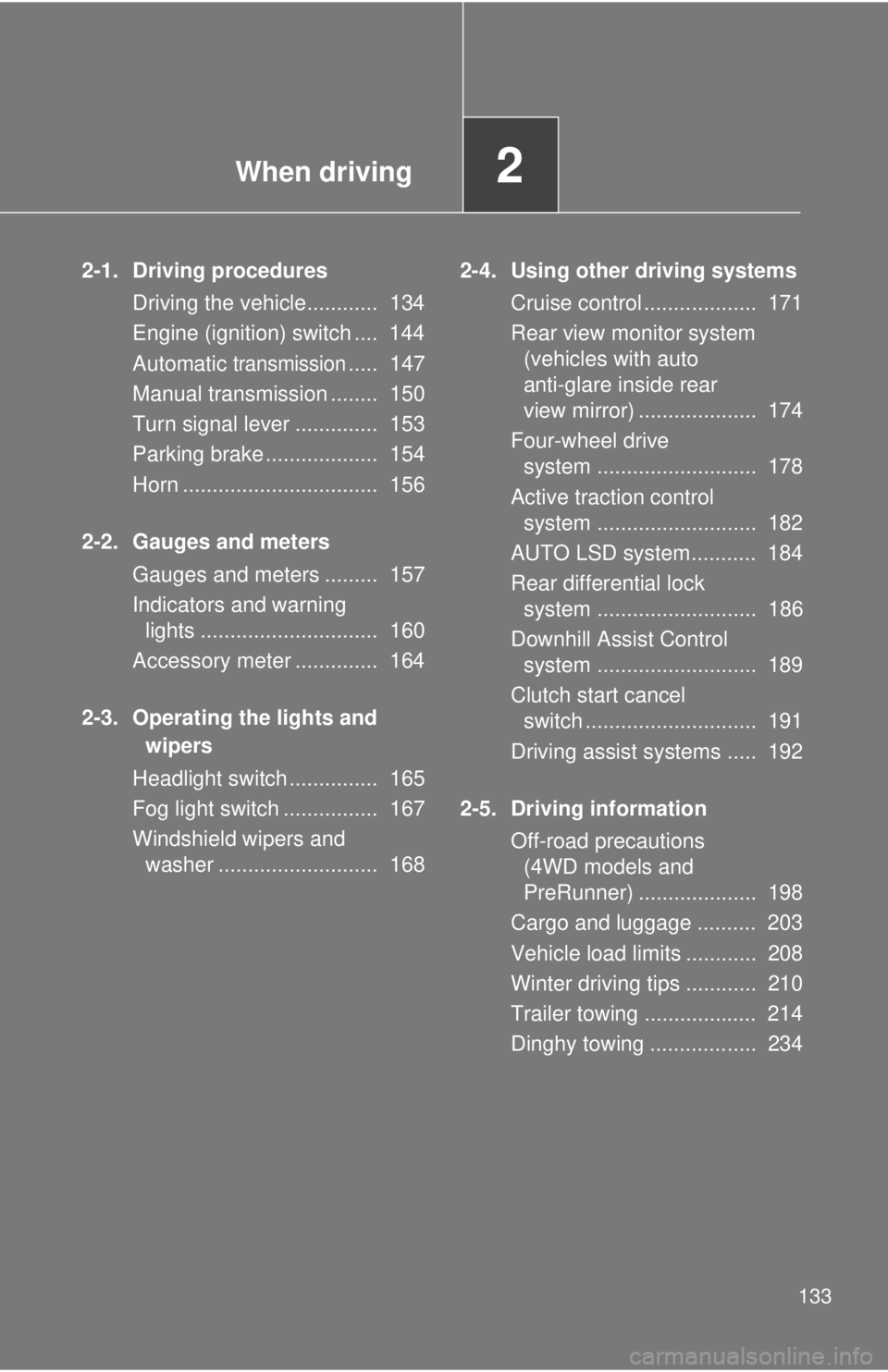
When driving2
133
2-1. Driving proceduresDriving the vehicle............ 134
Engine (ignition) switch .... 144
Automatic
transmission..... 147
Manual transmission ........ 150
Turn signal lever .............. 153
Parking brake ................... 154
Horn ................................. 156
2-2. Gauges and meters Gauges and meters ......... 157
Indicators and warning lights .............................. 160
Accessory meter .............. 164
2-3. Operating the lights and wipers
Headlight switch ............... 165
Fog light switch ................ 167
Windshield wipers and washer ........................... 168 2-4. Using other driving systems
Cruise control ................... 171
Rear view monitor system (vehicles with auto
anti-glare inside rear
view mirror) .................... 174
Four-wheel drive system ........................... 178
Active traction control system ........................... 182
AUTO LSD system........... 184
Rear differential lock system ........................... 186
Downhill Assist Control system ........................... 189
Clutch start cancel switch ............................. 191
Driving assist systems ..... 192
2-5. Driving information Off-road precautions (4WD models and
PreRunner) .................... 198
Cargo and luggage .......... 203
Vehicle load limits ............ 208
Winter driving tips ............ 210
Trailer towing ................... 214
Dinghy towing .................. 234
Page 161 of 548
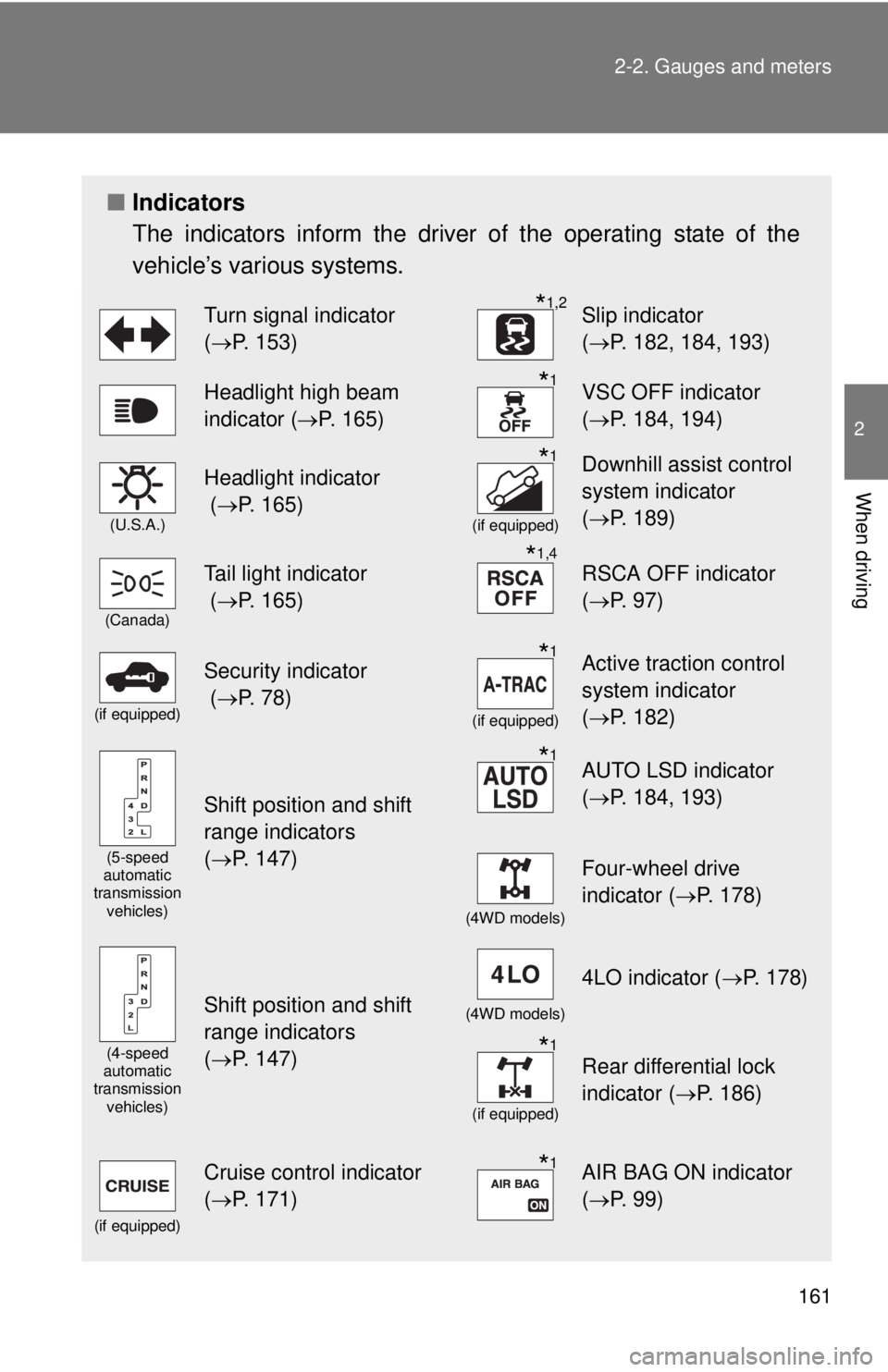
161
2-2. Gauges and meters
2
When driving
■
Indicators
The indicators inform the driver of the operating state of the
vehicle’s various systems.
Turn signal indicator
(P. 153)*1,2Slip indicator
( P. 182, 184, 193)
Headlight high beam
indicator ( P. 165)*1VSC OFF indicator
(P. 184, 194)
(U.S.A.)
Headlight indicator
( P. 165)*1
(if equipped)
Downhill assist control
system indicator
(P. 189)
(Canada)
Tail light indicator
( P. 165)*1,4RSCA OFF indicator
(P. 97)
(if equipped)
Security indicator
( P. 78)*1
(if equipped)
Active traction control
system indicator
(P. 182)
(5-speed
automatic
transmission
vehicles)
Shift position and shift
range indicators
(P. 147)
*1AUTO LSD indicator
( P. 184, 193)
(4WD models)
Four-wheel drive
indicator ( P. 178)
(4-speed
automatic
transmission
vehicles)
Shift position and shift
range indicators
(P. 147)(4WD models)
4LO indicator ( P. 178)
*1
(if equipped)
Rear differential lock
indicator (P. 186)
(if equipped)
Cruise control indicator
(P. 171)*1AIR BAG ON indicator
( P. 99)
Page 178 of 548
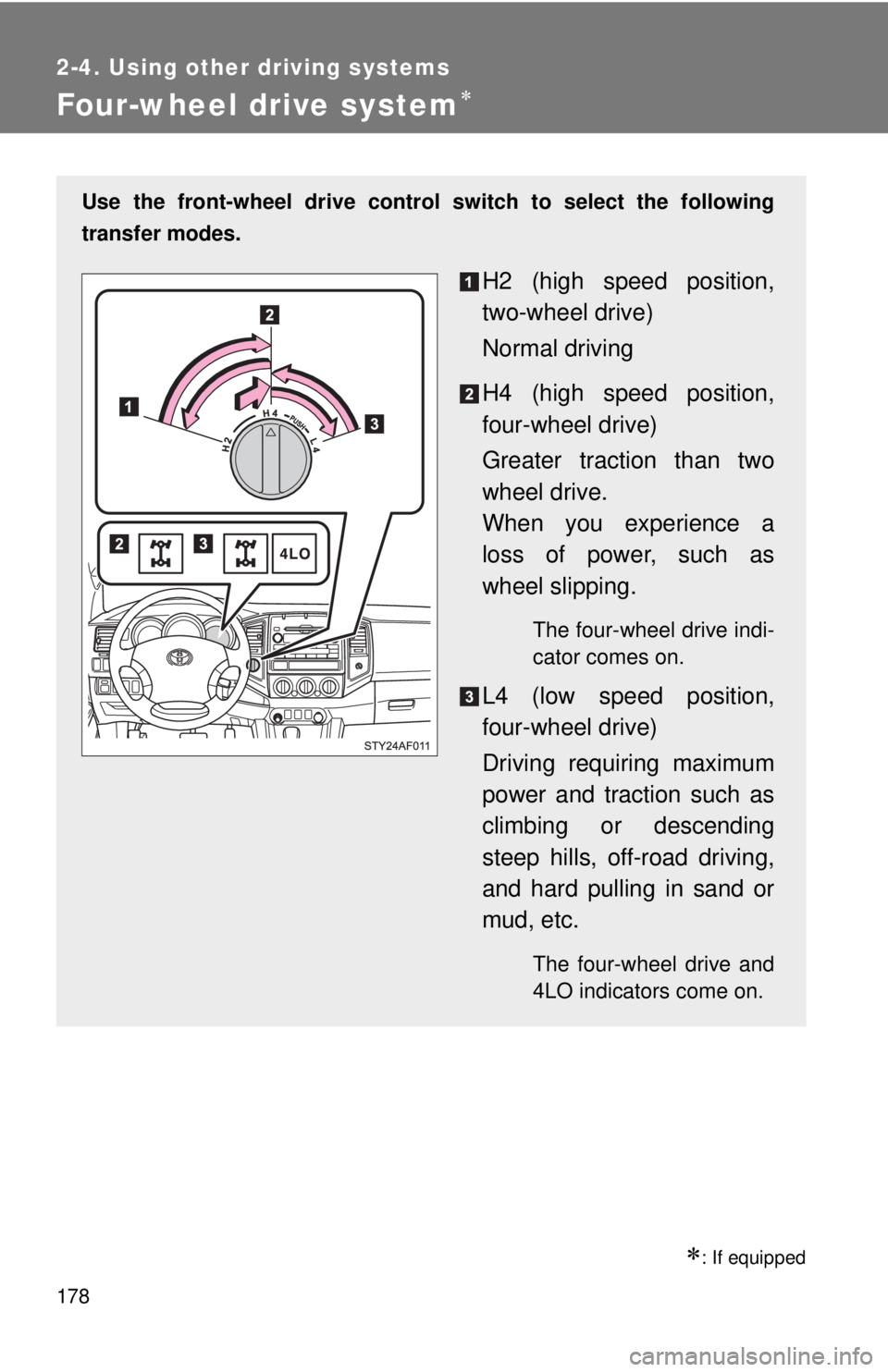
178
2-4. Using other driving systems
Four-wheel drive system
: If equipped
Use the front-wheel drive control switch to select the following
transfer modes.
H2 (high speed position,
two-wheel drive)
Normal driving
H4 (high speed position,
four-wheel drive)
Greater traction than two
wheel drive.
When you experience a
loss of power, such as
wheel slipping.
The four-wheel drive indi-
cator comes on.
L4 (low speed position,
four-wheel drive)
Driving requiring maximum
power and traction such as
climbing or descending
steep hills, off-road driving,
and hard pulling in sand or
mud, etc.
The four-wheel drive and
4LO indicators come on.
Page 182 of 548
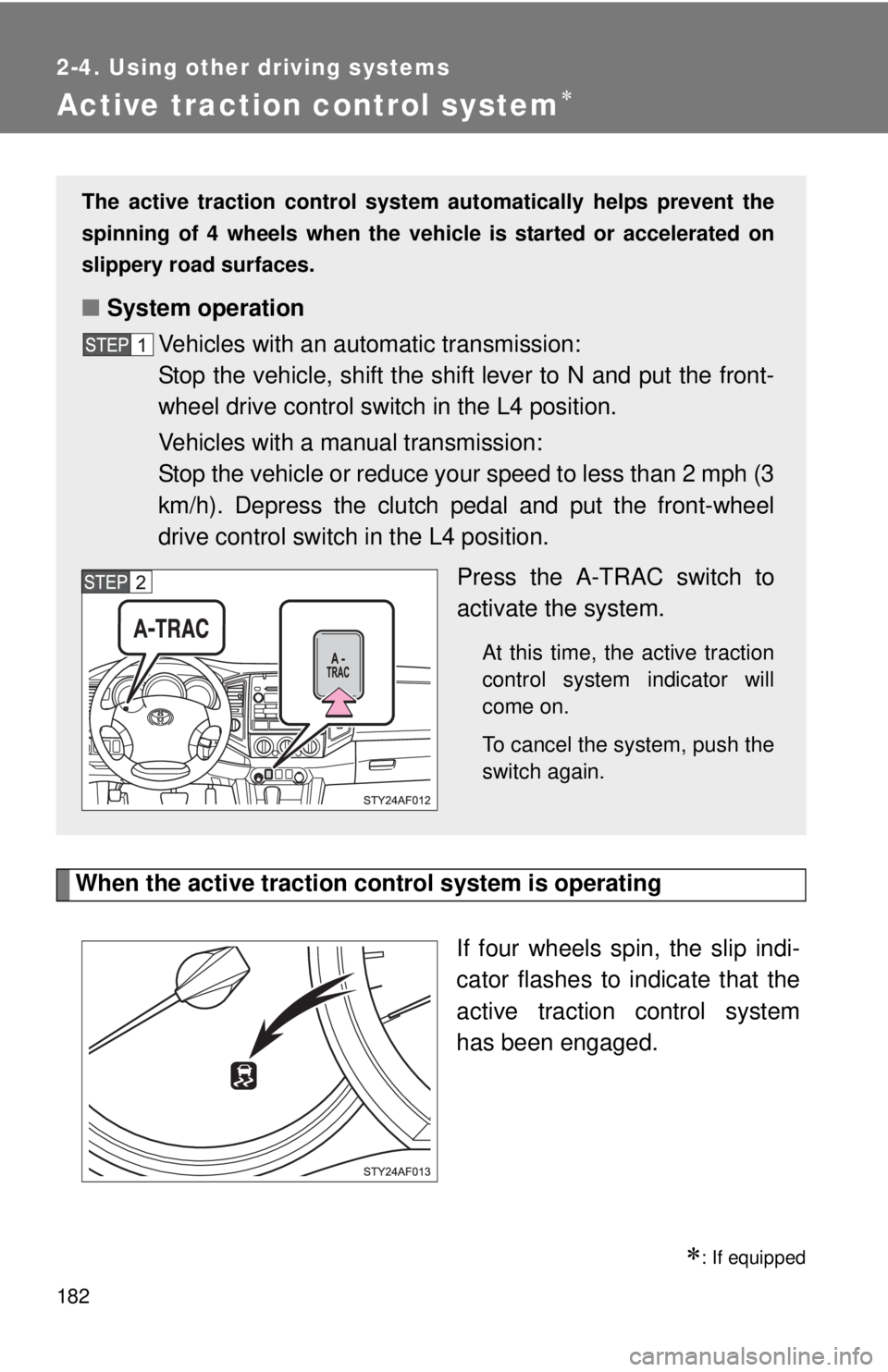
182
2-4. Using other driving systems
Active traction control system
When the active traction control system is operatingIf four wheels spin, the slip indi-
cator flashes to indicate that the
active traction control system
has been engaged.
: If equipped
The active traction control system automatically helps prevent the
spinning of 4 wheels when the vehicle is started or accelerated on
slippery road surfaces.
■ System operation
Vehicles with an automatic transmission:
Stop the vehicle, shift the shift lever to N and put the front-
wheel drive control switch in the L4 position.
Vehicles with a manual transmission:
Stop the vehicle or reduce your speed to less than 2 mph (3
km/h). Depress the clutch pedal and put the front-wheel
drive control switch in the L4 position.
Press the A-TRAC switch to
activate the system.
At this time, the active traction
control system indicator will
come on.
To cancel the system, push the
switch again.
Page 183 of 548
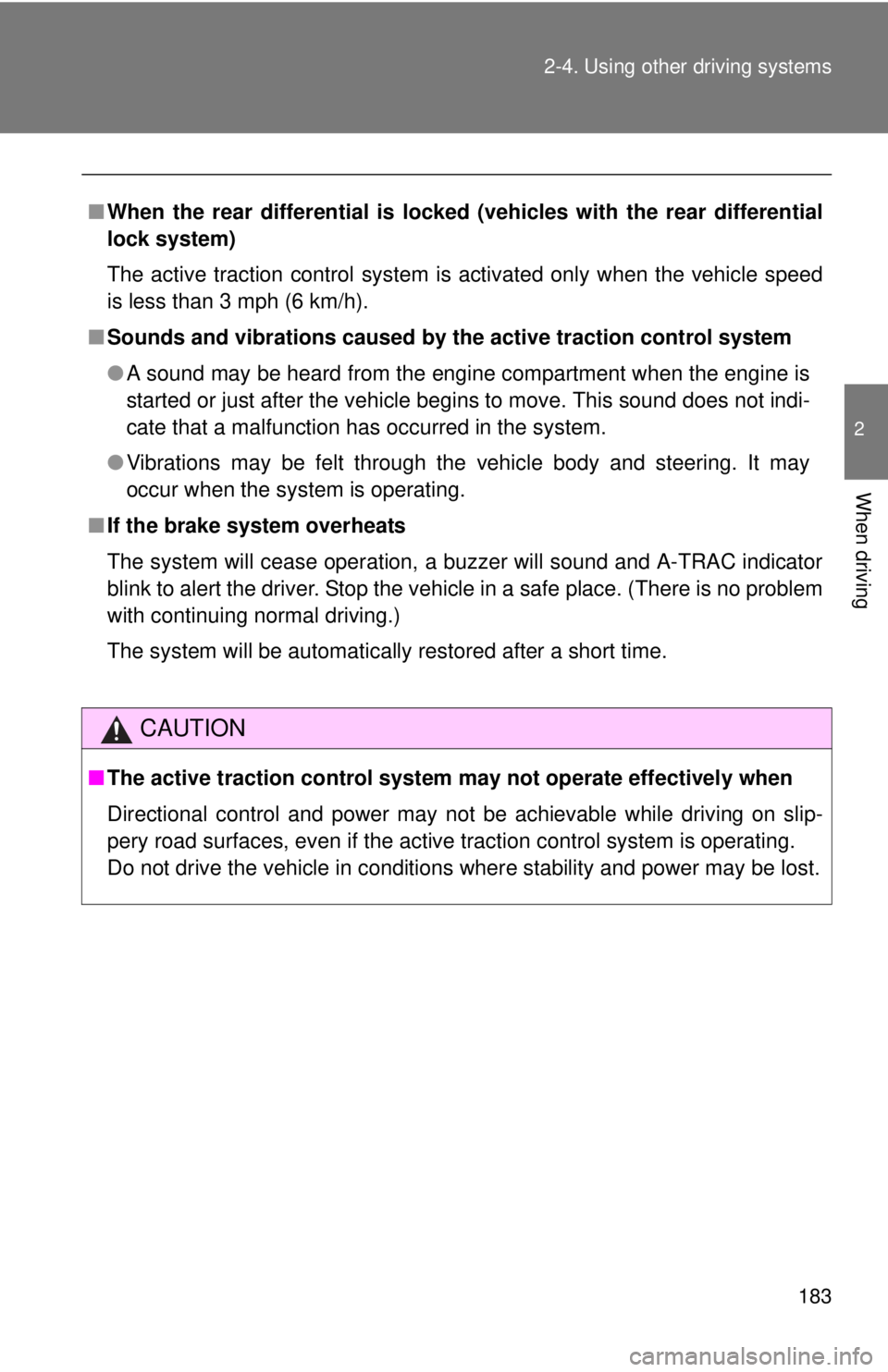
183
2-4. Using other
driving systems
2
When driving
■When the rear differential is locked (vehicles with the rear differential
lock system)
The active traction control system is activated only when the vehicle speed
is less than 3 mph (6 km/h).
■ Sounds and vibrations caused by the active traction control system
●A sound may be heard from the engine compartment when the engine is
started or just after the vehicle begins to move. This sound does not indi-
cate that a malfunction has occurred in the system.
● Vibrations may be felt through the vehicle body and steering. It may
occur when the system is operating.
■ If the brake system overheats
The system will cease operation, a buz zer will sound and A-TRAC indicator
blink to alert the driver. Stop the vehicle in a safe place. (There is no problem
with continuing normal driving.)
The system will be automatically restored after a short time.
CAUTION
■ The active traction control system m ay not operate effectively when
Directional control and power may not be achievable while driving on slip-
pery road surfaces, even if the active traction control system is operating.
Do not drive the vehicle in conditions where stability and power may be lost.
Page 184 of 548
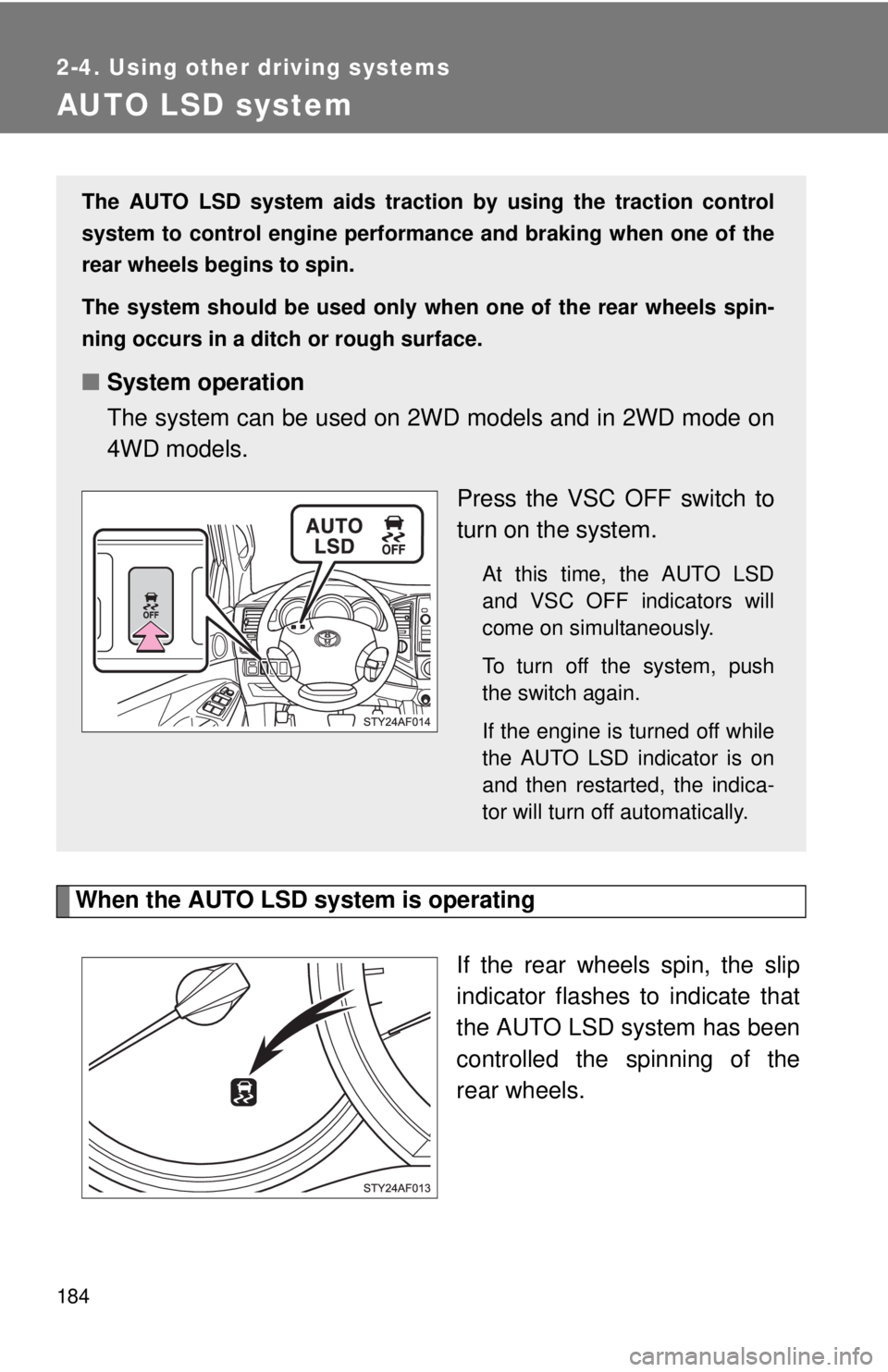
184
2-4. Using other driving systems
AUTO LSD system
When the AUTO LSD system is operatingIf the rear wheels spin, the slip
indicator flashes to indicate that
the AUTO LSD system has been
controlled the spinning of the
rear wheels.
The AUTO LSD system aids traction by using the traction control
system to control engine performance and braking when one of the
rear wheels begins to spin.
The system should be used only wh en one of the rear wheels spin-
ning occurs in a ditch or rough surface.
■ System operation
The system can be used on 2W D models and in 2WD mode on
4WD models.
Press the VSC OFF switch to
turn on the system.
At this time, the AUTO LSD
and VSC OFF indicators will
come on simultaneously.
To turn off the system, push
the switch again.
If the engine is turned off while
the AUTO LSD indicator is on
and then restarted, the indica-
tor will turn off automatically.
Page 192 of 548
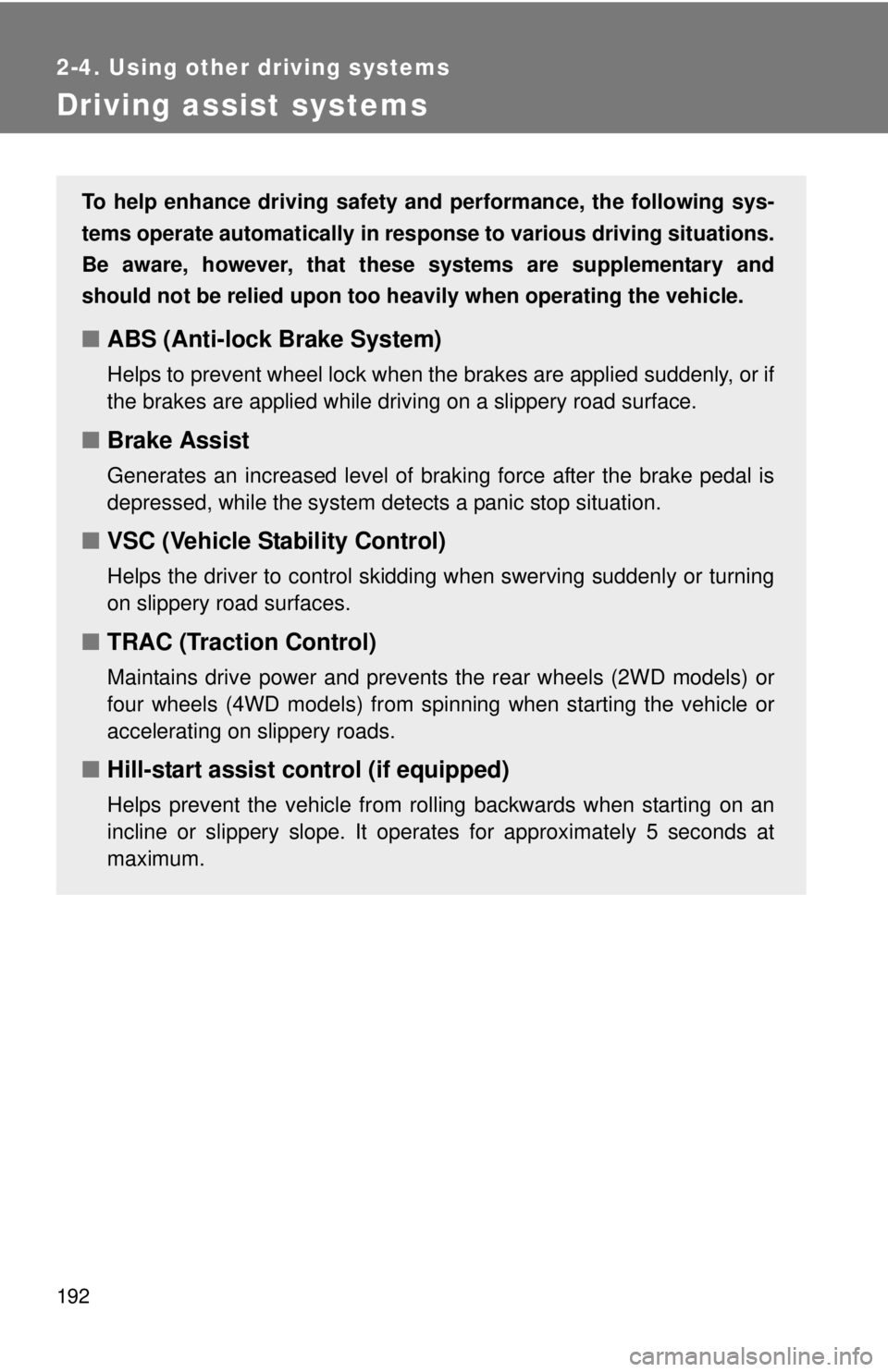
192
2-4. Using other driving systems
Driving assist systems
To help enhance driving safety and performance, the following sys-
tems operate automatically in res ponse to various driving situations.
Be aware, however, that these systems are supplementary and
should not be relied upon too h eavily when operating the vehicle.
■ABS (Anti-lock Brake System)
Helps to prevent wheel lock when the brakes are applied suddenly, or if
the brakes are applied while driving on a slippery road surface.
■Brake Assist
Generates an increased level of braking force after the brake pedal is
depressed, while the system detects a panic stop situation.
■VSC (Vehicle Stability Control)
Helps the driver to control skidding when swerving suddenly or turning
on slippery road surfaces.
■TRAC (Traction Control)
Maintains drive power and prevents the rear wheels (2WD models) or
four wheels (4WD models) from sp inning when starting the vehicle or
accelerating on slippery roads.
■ Hill-start assist control (if equipped)
Helps prevent the vehicle from rolling backwards when starting on an
incline or slippery slope. It operates for approximately 5 seconds at
maximum.
Page 415 of 548
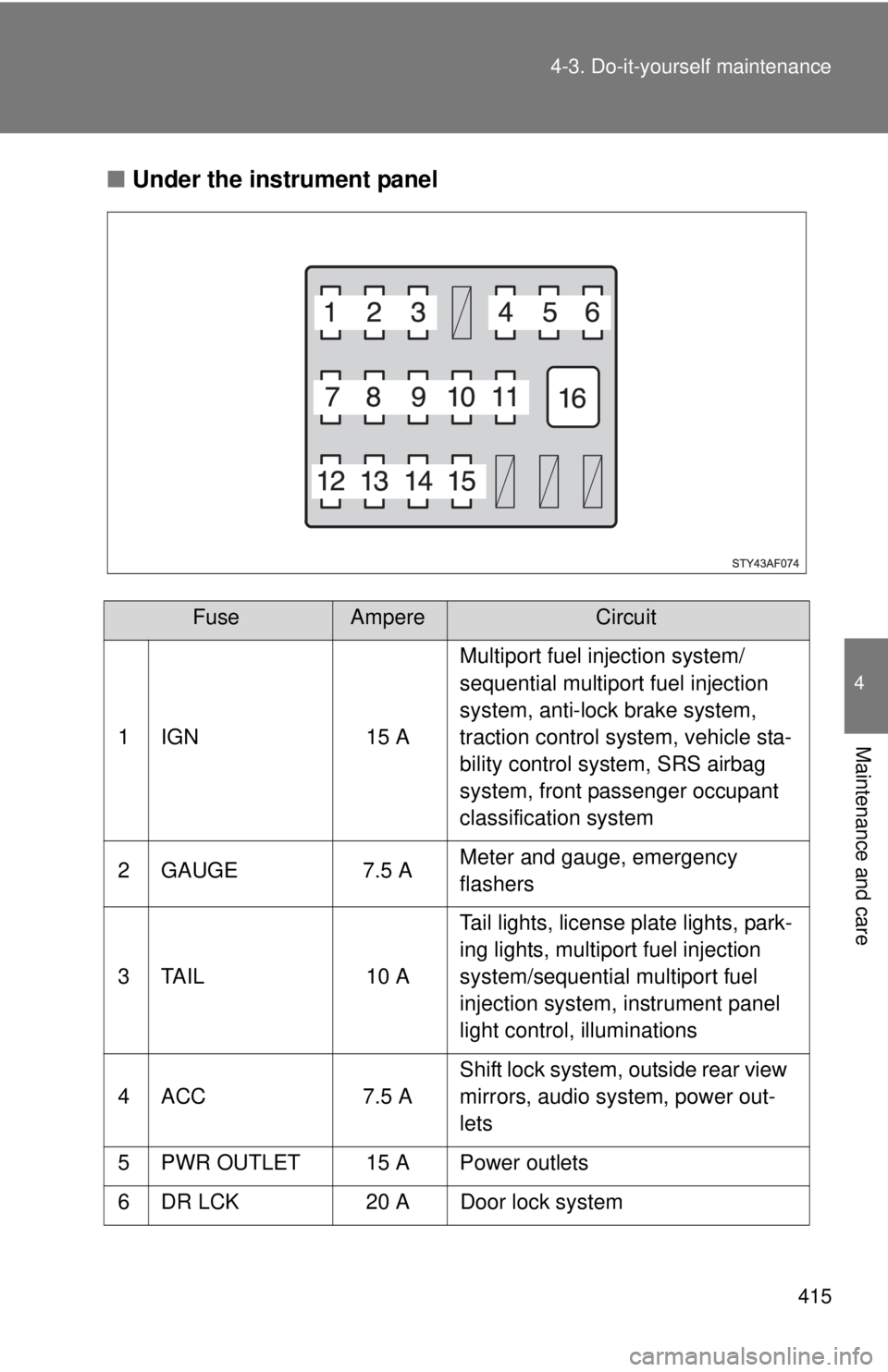
415
4-3. Do-it-yourself maintenance
4
Maintenance and care
■
Under the instrument panel
FuseAmpereCircuit
1 IGN 15 A Multiport fuel injection system/
sequential multiport fuel injection
system, anti-lock brake system,
traction control system, vehicle sta-
bility control system, SRS airbag
system, front passenger occupant
classification system
2 GAUGE 7.5 A Meter and gauge, emergency
flashers
3 TAIL 10 A Tail lights, license plate lights, park-
ing lights, multiport fuel injection
system/sequential multiport fuel
injection system, instrument panel
light control, illuminations
4 ACC 7.5 A Shift lock system, outside rear view
mirrors, audio system, power out-
lets
5 PWR OUTLET 15 A Power outlets
6 DR LCK 20 A Door lock system